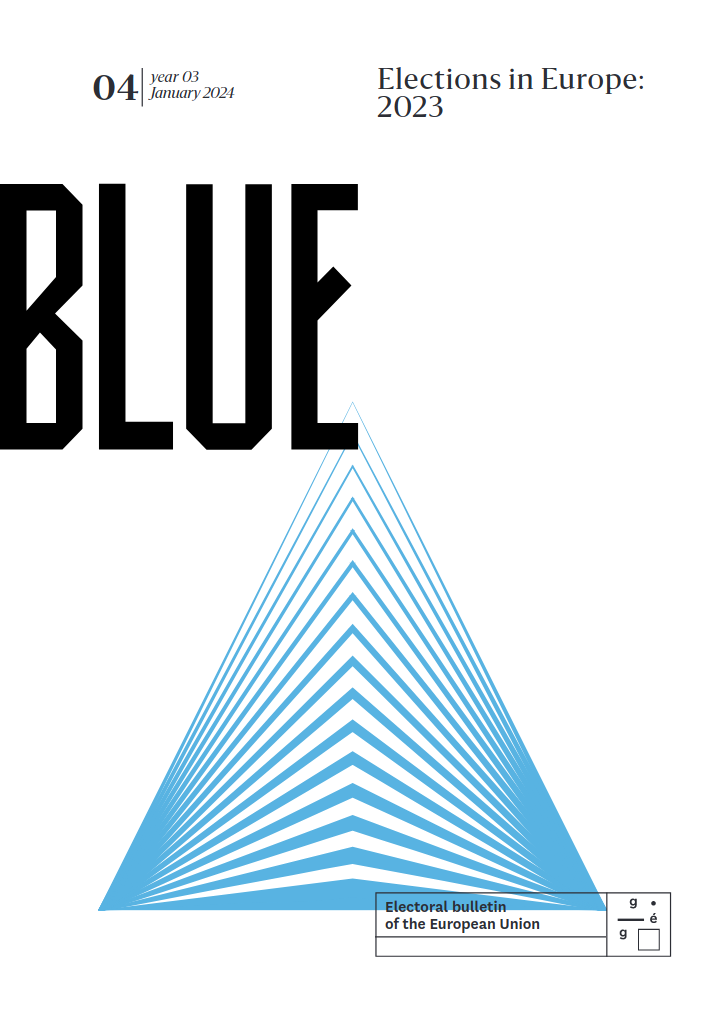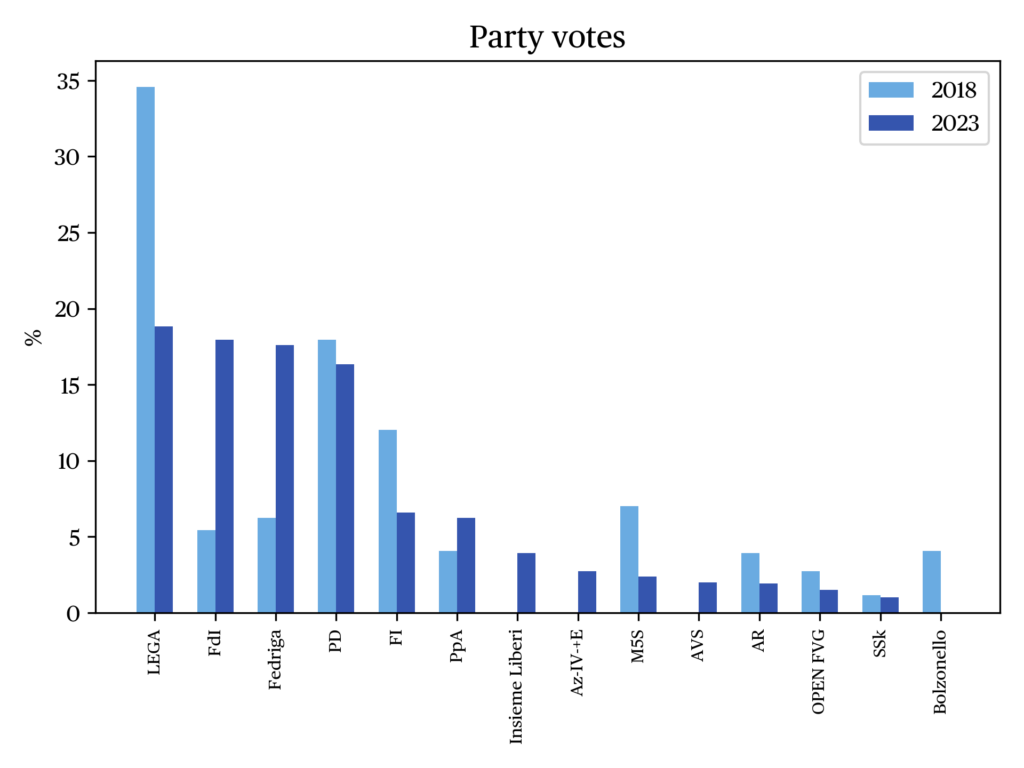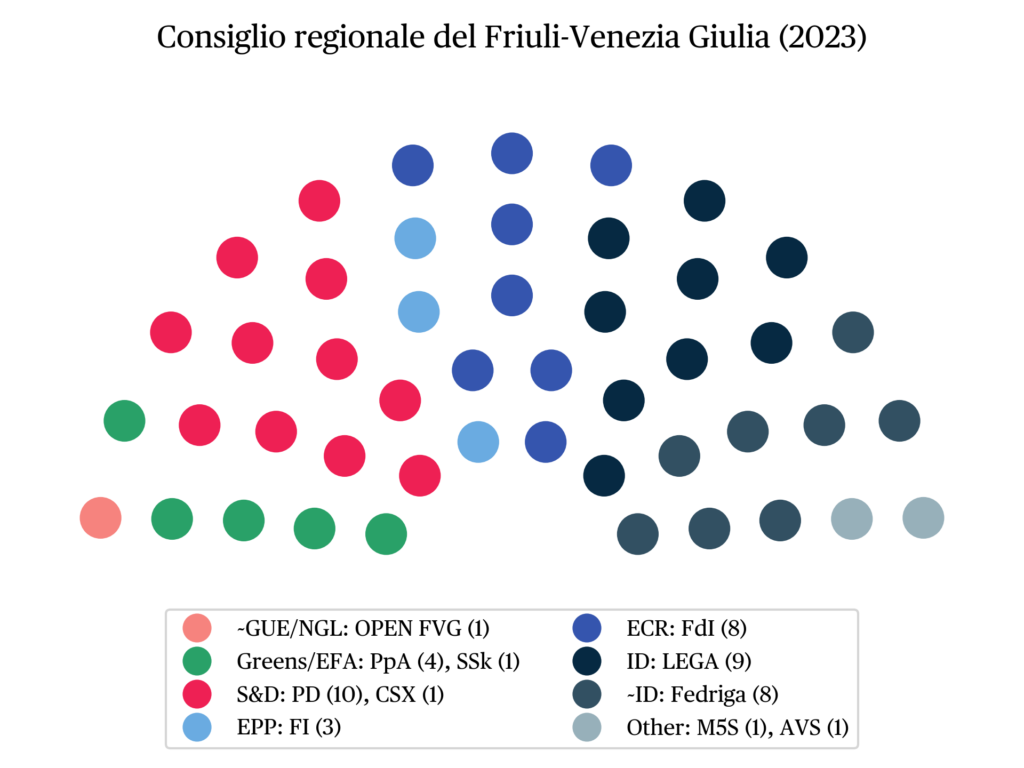Regional election in Friuli Venezia Giulia, 2-3 April 2023
Elisabetta De Giorgi
Associate Professor at the University of TriesteIssue
Issue #4Auteurs
Elisabetta De Giorgi
Issue 4, January 2024
Elections in Europe: 2023
Introduction
In 2023, elections were held in 5 Italian regions (3 with ordinary statute and 2 with special statute): Lazio and Lombardy (12 and 13 February), Friuli-Venezia Giulia (2 and 3 April), Molise (25 and 26 June), and Trentino-Alto Adige (22 October). Unlike in other European countries, in Italy there is no single election day common to all regions ; instead, each region sets its election day independently.
Since the mid-1990s, the regions have undergone several reforms. From an institutional point of view, they have acquired new competences and have been granted greater fiscal power and statutory autonomy, and their governments have become more stable through the introduction of the direct election of regional presidents. From an organizational point of view, various administrative reforms have contributed to improving the efficiency and effectiveness of public management (Baldi 2011).
Before 1999, the statutes of regions with ordinary statutes were to be approved by state law (Law 108/1968) and for regional elections the proportional electoral system was the same throughout the country. In 1999, with the approval of a constitutional reform (Constitutional Law 1/1999), the regions with ordinary statute were granted the right to give themselves their own statutes and to define their electoral system, in compliance with the fundamental principles laid down by state law (currently, Law 165/2004).
In this paper, we will focus on the elections held in last April in Friuli Venezia Giulia, one of the five Italian regions with special statute.
Elections and electoral system
The first regional election in Friuli Venezia Giulia (FVG) was held in 1964, a few years earlier than in the ordinary statute regions, which did not hold their own until 1970. In FVG, which lies on the border between Austria and present-day Slovenia, autonomy was granted not only because of the issue of the city of Trieste and the territorial disputes with Yugoslavia following the Second World War, but also because the area was facing long-lasting economic challenges.
At the time of the 1999 reform, the regions with special statute lagged behind the others. In fact, it was only the constitutional reform of 2001 (Constitutional Law 2/2001) that amended the statute of Friuli Venezia Giulia (Constitutional Law 1/1963, Art. 12) to establish that, with its own ‘reinforced’ regional law – the so-called ‘statute law’ – the region could determine its own form of government and procedures for electing the Regional Council and the President. The FVG Region, like all other regions both with and without special statute, opted for the direct election of the President and the Regional Council.
The President of the Region and the Regional Council are elected simultaneously. To this end, the regional territory is divided into five electoral districts: Trieste, Gorizia, Udine, Tolmezzo and Pordenone. In each electoral district, lists are presented, while the constituency for the election of the President of the Region coincides with the entire regional territory. Each constituency list is linked to a Presidential candidate. There are 48 councilors to be elected, including the President-elect and the first of the non-elected Presidential candidates.
The Presidential candidate who obtains the highest number of valid votes in the first (and only) round of voting is elected President of the region. If the winning presidential candidate has obtained over 45% of the vote, they will obtain a majority bonus guaranteeing them at least 60% of the seats. If the winner obtained less than 45% of the valid votes, they will be allocated at least 55% of the seats (including the seat reserved for the President). The other groups of eligible lists obtain at least 40% of the seats. The seats are distributed according to the region-wide result of each group using proportional representation.
Candidates
At the time of the vote in April 2023, at national level the government headed by Giorgia Meloni had been in office for about six months. After the resignation of the Draghi government in July 2022, general elections had been held in September, the outcome of which represented a decisive shift to the right in Italian politics. The center-right coalition gained a strong parliamentary majority – a result it had not achieved since 2008 – and Fratelli d’Italia (FdI), a party located at the far right of the political spectrum, emerged as the largest party both within the winning coalition and overall. Within the center-right, the balance between the political forces, which once saw Forza Italia (FI) firmly in the lead, had already begun to change in 2018, with Matteo Salvini’s Lega establishing itself as the new dominant force. But the most notable change occurred with the 2022 election that saw Giorgia Meloni’s FdI rise from 4.3% in the previous elections to 25.9%, leaving its government allies, Lega and FI, at 8.8 and 8.1% respectively (Chiaramonte et al. 2022).
The regional election in FVG therefore also represented an opportunity for the center-right to test their strength six months after the first Meloni government took office – this despite some observers’ belief that, in recent years, regional elections in Italy have followed a logic of their own, dominated by local leaders rather than national parties (Vampa 2021). There were four candidates for the presidency of the region: outgoing President Massimiliano Fedriga (Lega), supported by the center-right coalition; Massimo Morettuzzo, supported by the center-left coalition; Alessandro Maran for the Third Pole; and Giorgia Tripoli, standing for the Insieme Liberi list. At the same time, as always happens, votes were also held for the renewal of the entire regional council.
Fedriga had been leading the regional government since 3 May 2018 and, at the time of the election, had also led the Conference of Regions and Autonomous Provinces for about a year. He had been a member of the Chamber of Deputies for three consecutive terms and the leader of Lega’s group in the Chamber of Deputies from 2014 to 2018. At the time of the election, Fedriga was popular as a Regional President and Lega leader, both on a regional and a national scale. Matteo Salvini’s Lega, on the other hand, had suffered such a sharp decline in its vote share that Fedriga’s decision to also run with his own list – Fedriga Presidente – had been interpreted by many observers as an attempt at distancing himself from the party secretary. However, Fedriga was quick to justify his decision by the fact that, in his opinion, ‘many voters do not recognize themselves in parties’ (Moscatelli 2023), dismissing the theory of an internal feud between Salvini and the Lega presidents from the northern regions.
The Presidential candidate of the center-left coalition was Morettuzzo, a local businessman and politician, former mayor of a town in the province of Udine and regional secretary of the Patto per l’autonomia, an autonomist, pro-European and environmentalist party for which he had been a councillor since 2018. The coalition included both the Democratic Party (PD) and the 5 Star Movement (M5S), which had not always stood together at local and regional level, let alone at national level. Along with the PD and M5S, Morettuzzo was also supported by a number of civic lists, including his own, the Green Left Alliance list and the party of the Slovenian minority (Slovenska Skupnost).
The other two candidates were Alessandro Maran of the Third Pole – a centrist party created for the 2022 parliamentary elections, consisting of Italia Viva of former prime minister and PD secretary Matteo Renzi and Azione of former minister Carlo Calenda; and Giorgia Tripoli of the Insieme Liberi list, which gathered members of the anti-vax and ‘no green pass’ movements formed in the years of the pandemic.
Results
According to all pre-election polls, the outgoing President Massimiliano Fedriga was expected to win the election. In recent years, Fedriga had become one of Lega’s best-known ‘regional’ faces. Despite these clear expectations, the election was highly anticipated for several reasons. First of all, within the center-right, the balance between the different parties remained uncertain; this uncertainty was accentuated by the presence of Fedriga’s own civic list. In 2020, the Lega’s Luca Zaia had set a precedent in Veneto, where his personal list obtained three times as many votes as the Lega and four times as many as Fratelli d’Italia. Of course, compared to 2020, the balance of power within the center-right coalition was completely changed. The main question was whether Fratelli d’Italia would outperform their allies even in a region where the Lega had traditionally been strong. Furthermore, the elections in FVG were a test for the new secretary of the Democratic Party, Elly Schlein, who had been the surprise winner of the party primaries just over a month earlier.
The turnout in the election of the President of the Region and the Regional Council was as follows: 502,203 out of 1,109,395 registered voters turned out to vote (45.26%). The constituency in which the least votes were cast was Trieste (40.62%), which is also the most urban; the one in which the most votes were cast was Udine with 48.82% (Autonomous Region FVG 2023) – a figure that can also be explained by the fact that he Municipality of Udine was also called to vote to elect its Mayor and City Council. Compared to 2018, however, a significant drop in turnout was observed at both regional and constituency level: five years earlier, the regional turnout was 49.61%, more than four percentage points higher than in 2023, while turnout in the constituencies of Trieste and Udine was 43.69% and 52.60% respectively. This negative trend mirrors those recorded nationwide in 2022, although less sharply: the turnout rate in the 2022 general election was 63.9%, a loss of no less than 9 points compared to the previous (2018) election and an unprecedented increase in abstention (Chiaramonte et al. 2022).
| 2023 | 2018 | |
| Trieste | 40.62% | 43.69% |
| Gorizia | 45.48% | 52.60% |
| Udine | 48.82% | 52.60% |
| Tolmezzo | 43.03% | 47.58% |
| Pordenone | 44.14% | 49.81% |
| FVG (all) | 45.26% | 49.61% |
Source: FVG region
Incumbent President Massimiliano Fedriga – the first regional president to win a second term of office since the introduction of the direct election of the President – was successfully reelected, obtaining 64.3% of the vote. In the end, Fedriga won in a landslide, carrying a 36-percentage-point advantage over the second-placed candidate, the center-left’s Massimo Morettuzzo. The incumbent governor also beat its own record, obtaing 7 points more than in 2018 (when he stopped at 57%). Lastly, he obtained another noteworthy result at a delicate moment for the future of his own party and the internal balance in the center-right coalition: his personal list, Fedriga Presidente, obtained the same number of councillors as Fratelli d’Italia, albeit obtaining a slightly lower percentage of the vote, while the Lega obtained only one more seat.
| Candidates | Lists | Vote share |
| Massimiliano Fedriga | Autonomia Responsabile Fedriga Presidente Forza Italia Fratelli d’Italia Lega | 64.24% |
| Massimo Morettuzzo | Alleanza Verdi Sinistra Movimento 5 Stelle Open FVG Partito Democratico Patto per l’Autonomia Slovenska Skupnost | 28.37% |
| Giorgia Tripoli | Insieme Liberi | 4.66% |
| Alessandro Maran | Terzo Polo | 2.73% |
Source: FVG region
Among the center-left forces, the Five Star Movement obtained the worst result with only 2.4% of the votes and one seat in the Council – a result that, although in line with a tendency of the Movement not to stand out electorally in regional elections, is decidedly lower than in the past. In 2018, when it stood in the elections with its own candidate, it took 11.67% of the vote. Compared to the previous election, the Democratic Party also suffered a slight setback, with 16.5% in support compared to 18.11 in 2018. However, it gained 10 seats, one more than in the previous legislature. Finally, among the other parties of the center-left coalition, the party of the Slovenian minority, Slovenska Skupnost, obtained 1.02% and one seat, as did the Left Green Alliance and Open FVG, which together with the Five Star Movement became part of the Mixed Group of the Regional Council.
| Coalitions | Lists | Vote share |
| Coalition Massimiliano Fedriga / Center-right | Autonomia Responsabile | 19.7% |
| Fedriga Presidente | 17.76% | |
| Forza Italia | 6.66% | |
| Fratelli d’Italia | 18.11% | |
| Lega | 19.03% | |
| Coalition Massimo Morettuzzo / Center-left | Alleanza Verdi Sinistra | 2.03% |
| Movimento 5 Stelle | 2.4% | |
| Open FVG | 1.51% | |
| Partito Democratico | 16.5% | |
| Patto per l’Autonomia | 6.29% | |
| Slovenska Skupnost | 1.02% | |
| Coalition Giorgia Tripoli | Insieme Liberi | 3.98% |
| Coalition Alessandro Maran | Terzo Polo | 2.75% |
Source: FVG region
Finally, the result of the Insieme Liberi (Together Free) list – which, as we said, included anti-vax and ‘no green pass’ candidates – is to be noted. While not exceed the 4% threshold that would have allowed it to obtain seats in the Regional Council, the list nevertheless obtained a rather significant result – as had already happened to the anti-vax lists that had run in the municipal elections in Trieste and Udine. The Friuli Venezia Giulia region, especially its capital, had been at the center of the debate and demonstrations related to vaccines and the introduction of a mandatory ‘green pass’ in 2021. The movements that originated at that time were able to politically capitalize on that success and translate it into electoral support.
In the new Regional Council, the largest party within the majority coalition is the Lega with 9 councillors, followed by Lista Fedriga and Fratelli d’Italia with 8 seats each; the largest opposition party is the PD with 10 councillors.
The Lega remained the leading party in the region with just over 19% of the vote, despite the fact that Fedriga’s list, from the same party, had taken around 17.7%. Within the center-right coalition, Giorgia Meloni’s party, Fratelli d’Italia, suffered a sharp downsizing compared to the 2022 election, gathering about 18.1% of the vote – however, compared to the 2018 regional elections where it had obtained a mere 5.49%, it still gained more than ten percentage points. The latter result has, however, less to do with the popularity of Meloni and her government at the national level and much more to do with that of the outgoing president of the region, Fedriga, and his executive. As pointed out above, and as the regional elections held in 2020 have already amply demonstrated, at sub-national level regional presidents have acquired an increasingly central role during the Covid-19 pandemic. Against this backdrop, Massimiliano Fedriga’s outstanding electoral performance provides an additional confirmation of the capacity of Italian regional leaders to assert their autonomy from national politics (Vampa 2021).
The Data
Lists




Coalitions



References
Baldi, B. (2011). Le regioni. In Capano, G. & Gualmini, E. (eds.), Le pubbliche amministrazioni in Italia, Bologna: Il Mulino.
Chiaramonte, A., Emanuele, V., Maggini, N., & Paparo, A. (2022). Radical-Right Surge in a Deinstitutionalised Party System: The 2022 Italian General Election, South European Society and Politics, 27(3), 329-357.
Moscatelli, F. (2022, 10 December). Fedriga: “Molti non si riconoscono nei partiti, al voto ci sarà anche la mia lista”, La Stampa.
Vampa, D. (2021). The 2020 regional elections in Italy: sub-national politics in the year of the pandemic, Contemporary Italian Politics, 13(2), 166-180.
citer l'article
Elisabetta De Giorgi, Regional election in Friuli Venezia Giulia, 2-3 April 2023, Nov 2023,
à lire dans cette issue
voir toute la revue





